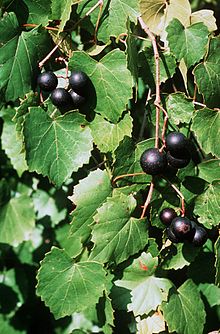
Back كرمة دائرية الأوراق Arabic كرمه دائرية الاوراق ARZ Vitis rotundifolia CEB Vitis rotundifolia German Vitis rotundifolia Esperanto Vitis rotundifolia Spanish Vitis rotundifolia French Vitis rotundifolia Italian マスカディンブドウ Japanese Vitis rotundifolia Latin
| Muscadine | |
|---|---|

| |
| Scientific classification | |
| Kingdom: | Plantae |
| Clade: | Tracheophytes |
| Clade: | Angiosperms |
| Clade: | Eudicots |
| Clade: | Rosids |
| Order: | Vitales |
| Family: | Vitaceae |
| Genus: | Vitis |
| Subgenus: | Vitis subg. Muscadinia |
| Species: | V. rotundifolia
|
| Binomial name | |
| Vitis rotundifolia | |
Vitis rotundifolia, or muscadine,[1] is a grapevine species native to the southeastern and south-central United States.[2] The growth range extends from Florida to New Jersey coast, and west to eastern Texas and Oklahoma.[3] It has been extensively cultivated since the 16th century.[4] The plants are well-adapted to their native warm and humid climate; they need fewer chilling hours than better known varieties, and thrive in summer heat.
Muscadine berries may be bronze or dark purple or black when ripe.[5] Wild varieties may stay green through maturity. Muscadines are typically used in making artisan wines, juice, hull pie and jelly. They are rich sources of polyphenols.[6]
In a natural setting, muscadine provides wildlife habitat as shelter, browse, and food for many birds and animals.[2] It is also a larval host for the Nessus Sphinx Moth (Amphion floridensis) and the Mournful Sphinx Moth (Enyo lugubris).[7]
- ^ USDA, NRCS (n.d.). "Vitis rotundifolia". The PLANTS Database (plants.usda.gov). Greensboro, North Carolina: National Plant Data Team. Retrieved 6 August 2015.
- ^ a b Peter C. Andersen; Timothy E. Crocker; Jacque Breman (2018). "The muscadine grape". Institute of Food and Agricultural Sciences, University of Florida. Retrieved 27 September 2019.
- ^ Biota of North America Program 2014 county distribution map
- ^ "Profile for Vitis rotundifolia (muscadine)". PLANTS Database. USDA, NRCS. Retrieved October 18, 2011.
- ^ Boning, Charles (2006). Florida's Best Fruiting Plants: Native and Exotic Trees, Shrubs, and Vines. Sarasota, Florida: Pineapple Press, Inc. p. 155. ISBN 1-56164-372-6.
- ^ Pastrana-Bonilla E, Akoh CC, Sellappan S, Krewer G (August 2003). "Phenolic content and antioxidant capacity of muscadine grapes". Journal of Agricultural and Food Chemistry. 51 (18): 5497–503. doi:10.1021/jf030113c. PMID 12926904.
- ^ "Muscadine, Muscadine grape". Natives for your Neighborhood.